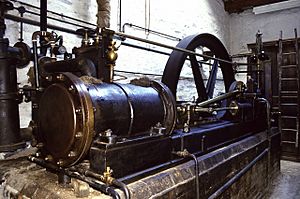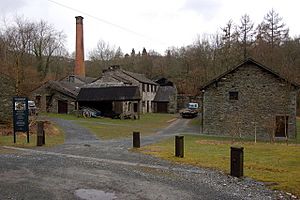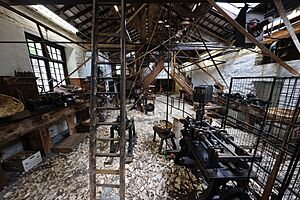Stott Park Bobbin Mill facts for kids

Stott Park Bobbin Mill is a fascinating old factory. It was built in the 1800s and made wooden bobbins. Today, it's a working museum near Newby Bridge, Cumbria, England.
Bobbins are small spools that hold thread or yarn. They were super important for the textile industry. This mill was one of over 65 in the Lake District that made bobbins. These bobbins were sent to factories in Lancashire and Yorkshire. The mill is now looked after by English Heritage.
Contents
The Mill's Story: A Look Back in Time
How Stott Park Bobbin Mill Started
The first part of the mill was built in 1835. A local landowner named John Harrison built it. He owned the land where the mill stands. It's special because it was built just for making bobbins. Many other mills were older buildings changed for this use.
There was a huge need for wooden bobbins back then. The cotton and textile industries were growing fast. The Lake District was perfect for making bobbins. It had lots of water for power. It also had many forests with wood for the bobbins. Harrison rented the mill out to different people.
Growing the Bobbin Business
In the 1850s, the Coward family leased the mill. They owned other bobbin mills too. They made the mill bigger, even when things got tough. New technology and the Cotton Famine in the 1860s threatened the bobbin industry. Many other mills in the Lake District closed.
But Stott Park kept going strong! A railway line was built in 1869. It had a station less than a mile away. This made it much easier to get materials and send out bobbins.
The End of an Era and a New Beginning
The Coward family bought the mill in the 1920s. They paid £4,000 for it. They ran the business until 1971. That's when the mill finally closed. The demand for wooden bobbins had dropped a lot. This was because plastic products became popular.
Stott Park was one of the last bobbin mills left. It became a protected historical site in 1973. The government bought it in 1974. This was to save it from being torn down. English Heritage took over in 1983. They opened it as a museum. Today, English Heritage runs the mill all by itself.
How the Mill Got Its Power
From Water to Steam to Electricity
When the mill first opened, a giant water wheel powered it. This wheel was 24 feet (about 7.3 meters) across! A stream from Roger Heights fed a pond behind the mill. This water turned the wheel. Later, a water turbine replaced the wheel. More reservoirs were built to hold water. One of these is High Dam, a beautiful spot today.
In the 1880s, a small steam engine was added. It was built by Bradley's of Brighouse. This engine helped power the mill when water levels were low. It even used waste wood from making bobbins as fuel! The steam engine worked until 1941. That's when the mill got electricity.
Today, the mill's machines run on an electric motor from the 1940s. You can still see the old steam engine working. It's run for visitors on special weekends.
Awards and Recognition
In 2014, Stott Park Bobbin Mill won an award. It was named the best small visitor attraction in Cumbria. The next year, it won a Silver award at the national Visit England Awards for Excellence.
What's in a Name: Stott Park
The name Stott Park comes from an old Cumbrian word. Stott means a young ox or bullock. Long ago, this whole area belonged to Furness Abbey. It was probably used as a park. This park provided a place for young cattle to graze.



